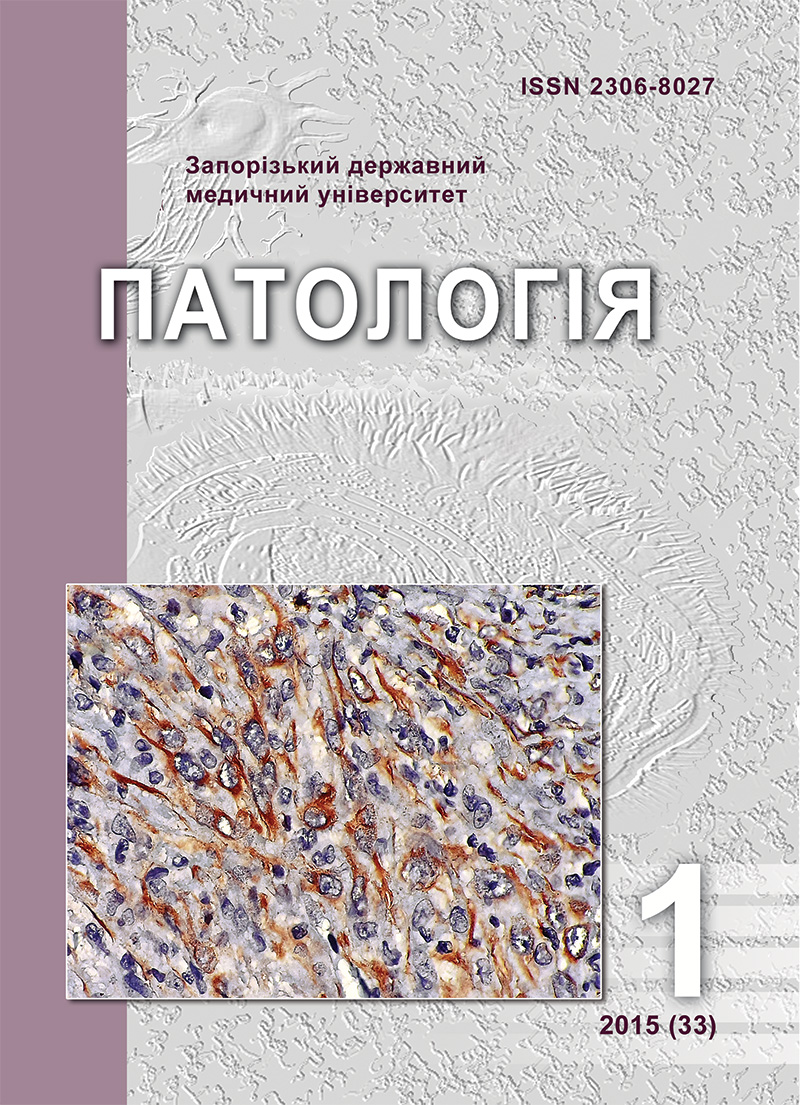Histopathological features and protein ubiquitin immunohistochemical expression in peritumoral tissue of the testicular germ cell tumors
DOI:
https://doi.org/10.14739/2310-1237.2015.1.42827Keywords:
Ovarian Neoplasms, Seminiferous Tubules, Proteins, TINAbstract
Aim. For the purpose of determination of characteristic morphological changes as well as the immunohistochemical protein Ubiquitin expression in peritumoral testicular tissue, which could be characterized as precancer lesions, the 40 patients with testicular germ cell tumors (TGCT) were investigated.
Methods and results. Peritumoral testicular tissue in patients with the spermatogenesis alteration (that was detected in 95% of cases) demonstrated: 1) the dramatic increase of ubiquitination processes in seminiferous tubules, confirming the intensive proteolysis of the damaged intracellular proteins, 2) occurrence of atypical germ cells (TIN), which differ from the normal spermatogenesis cells by the authentically lower levels of the nuclear and cytoplasmatic protein Ubiquitin expression, 3) alteration of ubiquitination processes in Leydig cells with the significant increase of the protein Ubiquitin cytoplasmatic expression and the total disappearance of protein Ubiquitin nuclear expression.
Conclusion. Our results show the important role of the structural and functional ubiquitin-proteolysis system components alterations at the initial stages of the testicular tissue carcinogenesis.
References
(2013) Rak v Ukraini, 2011–2012. Zakhvoriuvanist, smertnist, pokaznyky diialnosti onkolohichnoi sluzhby. [Cancer in Ukraine, 2011–2012. Disease, mortality, indicators of activity oncologic service]. Biuleten Natsionalnoho kantser-reiestru Ukrainy, 14. [in Ukrainian].
Ciechanover, A. (1998). The ubiquitin-proteasome pathway: on protein death and cell life. EMBO J., 17(24), 7151–7160. doi: 10.1093/emboj/17.24.7151.
Ciechanover, A. (2003). The ubiquitin proteolytic system and pathogenesis of human diseases: a novel platform for mechanism-based drug targeting. Biochem. Soc. Trans., 31(2), 474–481. :doi: 10.1042/BST0310474.
Huyghe, E., Soulie, M., Escourrou, G., Mieusset, R., Plante, P., & Thonneau,P. (2005). Conservative management of small testicular tumors relative to carcinoma in situ prevalence. J. Urol., 173, 820–823. doi: 10.1097/01.ju.0000152532.34475.4e.
Ng, J. M., Vrieling, H., Sugasawa, K., Ooms, M. P., Grootegoed, J. A, Vreeburg, J. T., et al. (2002). Developmental defects and male sterility in mice lacking the ubiquitin-like DNA repair gene mHR23B. Mol. Cell. Biol., 22(4), 1233–1245. doi: 10.1128/MCB.22.4.1233-1245.2002.
Malmstrum, P. U., Busch, C., Norben, B. J., & Andersson, B. (1998). Expression of ABH blood group isoantigen as a prognostic factor in transitional cell bladder carcinoma. Scand. J. Urol. Nephrol., 22, 265–270.
Mostofi, F. K., Sesterhenn, I. A., & Sobin, L. H. (1998). Histological typing of testis tumours. Berlin.
Tal, R., Holland, R., Belenky, A., Konichezky, M., & Baniel, J. (2004) Incidental testicular tumors in infertile men. Fertil. Steril., 82, 469–471. doi: 10.1016/j.fertnstert.2003.12.048.
Raman Jay, D., Nobert Craig, F., & Goldstein, M. (2005) Increased incidence of testicular cancer in men presenting with infertility and abnormal semen analysis. The Journal of Urology, 174, 1819–1822.
Bedard, N., Hingamp, P., Pang, Z., Karaplis, A., Morales, C., Trasler, J., et al. (2005). Mice lacking the UBC4-testis gene have a delay in postnatal testis development but normal spermatogenesis and fertility. Mol. Cell. Biol., 25(15), 6346–6354. doi: 10.1128/MCB.25.15.6346-6354.2005.
Linke, J., Loy, V., & Dieckmann, K. P. (2005). Prevalence of testicular intraepithelial neoplasia in healthy males. J. Urol, 173, 1577–1579. doi: 10.1097/01.ju.0000154348.68575.95.
Jonnes, T. D., MacLennan, G. T., Bonnin, J. M., Varsegi, M. F., Biair, J. E., Cheng, L. (2006). Screening for intratubular neoplasia of the testis using OCT4 immunoihistochemistry. Am. J. Surg. Pathology, 30(11), 1427–1431. doi: 10.1097/01.pas.0000213288.50660.f7.
Stoop, H., Honecker, F., van de Geijn, G. J., Gillis, A. J., Cools, M. C., de Boer, M., et al. (2008). Stem cell factor as a novel diagnostic marker for early malignant germ cells. J. Pathology, 216(1), 43–54. doi: 10.1002/path.2378.
Sutovsky, P. (2003). Ubiquitin-dependent proteolysis in mammalian spermatogenesis, fertilization, and sperm quality control: killing three birds with one stone. Microsc. Res. Tech., 61(1), 88–102. doi: 10.1002/jemt.10319.
Glickman, M. H., & Ciechanover, A. (2002). The ubiquitin-proteasome proteolytic pathway: destruction for the sake of construction. Physiol. Rev., 82, 373–428. doi: 10.1152/physrev.00027.2001.
Downloads
How to Cite
Issue
Section
License
Authors who publish with this journal agree to the following terms:- Authors retain copyright and grant the journal right of first publication with the work simultaneously licensed under a Creative Commons Attribution License that allows others to share the work with an acknowledgement of the work's authorship and initial publication in this journal.

- Authors are able to enter into separate, additional contractual arrangements for the non-exclusive distribution of the journal's published version of the work (e.g., post it to an institutional repository or publish it in a book), with an acknowledgement of its initial publication in this journal.
- Authors are permitted and encouraged to post their work online (e.g., in institutional repositories or on their website) prior to and during the submission process, as it can lead to productive exchanges, as well as earlier and greater citation of published work (SeeThe Effect of Open Access).

